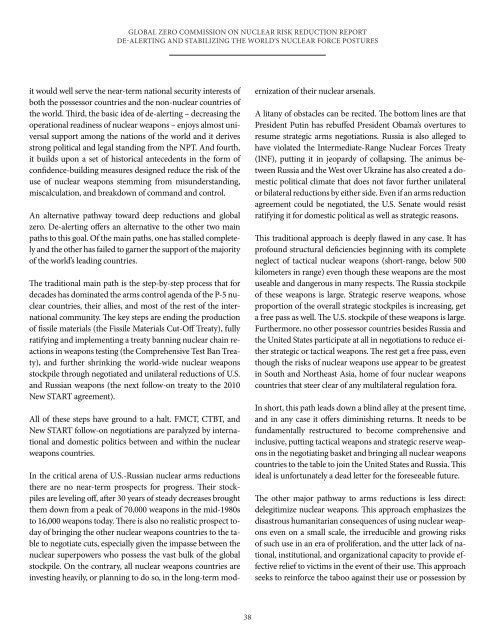global_zero_commission_on_nuclear_risk_reduction_report
global_zero_commission_on_nuclear_risk_reduction_report
global_zero_commission_on_nuclear_risk_reduction_report
You also want an ePaper? Increase the reach of your titles
YUMPU automatically turns print PDFs into web optimized ePapers that Google loves.
GLOBAL ZERO COMMISSION ON NUCLEAR RISK REDUCTION REPORTDE-ALERTING AND STABILIZING THE WORLD’S NUCLEAR FORCE POSTURESit would well serve the near-term nati<strong>on</strong>al security interests ofboth the possessor countries and the n<strong>on</strong>-<strong>nuclear</strong> countries ofthe world. Third, the basic idea of de-alerting – decreasing theoperati<strong>on</strong>al readiness of <strong>nuclear</strong> weap<strong>on</strong>s – enjoys almost universalsupport am<strong>on</strong>g the nati<strong>on</strong>s of the world and it derivesstr<strong>on</strong>g political and legal standing from the NPT. And fourth,it builds up<strong>on</strong> a set of historical antecedents in the form ofc<strong>on</strong>fidence-building measures designed reduce the <strong>risk</strong> of theuse of <strong>nuclear</strong> weap<strong>on</strong>s stemming from misunderstanding,miscalculati<strong>on</strong>, and breakdown of command and c<strong>on</strong>trol.An alternative pathway toward deep reducti<strong>on</strong>s and <str<strong>on</strong>g>global</str<strong>on</strong>g><str<strong>on</strong>g>zero</str<strong>on</strong>g>. De-alerting offers an alternative to the other two mainpaths to this goal. Of the main paths, <strong>on</strong>e has stalled completelyand the other has failed to garner the support of the majorityof the world’s leading countries.The traditi<strong>on</strong>al main path is the step-by-step process that fordecades has dominated the arms c<strong>on</strong>trol agenda of the P-5 <strong>nuclear</strong>countries, their allies, and most of the rest of the internati<strong>on</strong>alcommunity. The key steps are ending the producti<strong>on</strong>of fissile materials (the Fissile Materials Cut-Off Treaty), fullyratifying and implementing a treaty banning <strong>nuclear</strong> chain reacti<strong>on</strong>sin weap<strong>on</strong>s testing (the Comprehensive Test Ban Treaty),and further shrinking the world-wide <strong>nuclear</strong> weap<strong>on</strong>sstockpile through negotiated and unilateral reducti<strong>on</strong>s of U.S.and Russian weap<strong>on</strong>s (the next follow-<strong>on</strong> treaty to the 2010New START agreement).All of these steps have ground to a halt. FMCT, CTBT, andNew START follow-<strong>on</strong> negotiati<strong>on</strong>s are paralyzed by internati<strong>on</strong>aland domestic politics between and within the <strong>nuclear</strong>weap<strong>on</strong>s countries.In the critical arena of U.S.-Russian <strong>nuclear</strong> arms reducti<strong>on</strong>sthere are no near-term prospects for progress. Their stockpilesare leveling off, after 30 years of steady decreases broughtthem down from a peak of 70,000 weap<strong>on</strong>s in the mid-1980sto 16,000 weap<strong>on</strong>s today. There is also no realistic prospect todayof bringing the other <strong>nuclear</strong> weap<strong>on</strong>s countries to the tableto negotiate cuts, especially given the impasse between the<strong>nuclear</strong> superpowers who possess the vast bulk of the <str<strong>on</strong>g>global</str<strong>on</strong>g>stockpile. On the c<strong>on</strong>trary, all <strong>nuclear</strong> weap<strong>on</strong>s countries areinvesting heavily, or planning to do so, in the l<strong>on</strong>g-term modernizati<strong>on</strong>of their <strong>nuclear</strong> arsenals.A litany of obstacles can be recited. The bottom lines are thatPresident Putin has rebuffed President Obama’s overtures toresume strategic arms negotiati<strong>on</strong>s. Russia is also alleged tohave violated the Intermediate-Range Nuclear Forces Treaty(INF), putting it in jeopardy of collapsing. The animus betweenRussia and the West over Ukraine has also created a domesticpolitical climate that does not favor further unilateralor bilateral reducti<strong>on</strong>s by either side. Even if an arms reducti<strong>on</strong>agreement could be negotiated, the U.S. Senate would resistratifying it for domestic political as well as strategic reas<strong>on</strong>s.This traditi<strong>on</strong>al approach is deeply flawed in any case. It hasprofound structural deficiencies beginning with its completeneglect of tactical <strong>nuclear</strong> weap<strong>on</strong>s (short-range, below 500kilometers in range) even though these weap<strong>on</strong>s are the mostuseable and dangerous in many respects. The Russia stockpileof these weap<strong>on</strong>s is large. Strategic reserve weap<strong>on</strong>s, whoseproporti<strong>on</strong> of the overall strategic stockpiles is increasing, geta free pass as well. The U.S. stockpile of these weap<strong>on</strong>s is large.Furthermore, no other possessor countries besides Russia andthe United States participate at all in negotiati<strong>on</strong>s to reduce eitherstrategic or tactical weap<strong>on</strong>s. The rest get a free pass, eventhough the <strong>risk</strong>s of <strong>nuclear</strong> weap<strong>on</strong>s use appear to be greatestin South and Northeast Asia, home of four <strong>nuclear</strong> weap<strong>on</strong>scountries that steer clear of any multilateral regulati<strong>on</strong> fora.In short, this path leads down a blind alley at the present time,and in any case it offers diminishing returns. It needs to befundamentally restructured to become comprehensive andinclusive, putting tactical weap<strong>on</strong>s and strategic reserve weap<strong>on</strong>sin the negotiating basket and bringing all <strong>nuclear</strong> weap<strong>on</strong>scountries to the table to join the United States and Russia. Thisideal is unfortunately a dead letter for the foreseeable future.The other major pathway to arms reducti<strong>on</strong>s is less direct:delegitimize <strong>nuclear</strong> weap<strong>on</strong>s. This approach emphasizes thedisastrous humanitarian c<strong>on</strong>sequences of using <strong>nuclear</strong> weap<strong>on</strong>seven <strong>on</strong> a small scale, the irreducible and growing <strong>risk</strong>sof such use in an era of proliferati<strong>on</strong>, and the utter lack of nati<strong>on</strong>al,instituti<strong>on</strong>al, and organizati<strong>on</strong>al capacity to provide effectiverelief to victims in the event of their use. This approachseeks to reinforce the taboo against their use or possessi<strong>on</strong> by38


